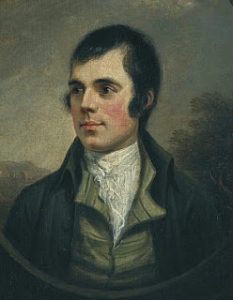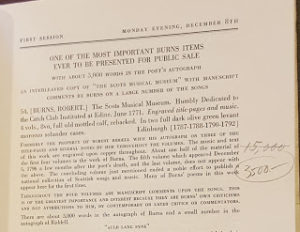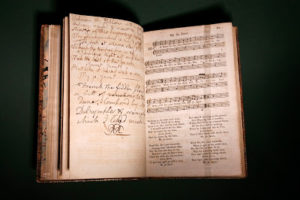This guest post is an excerpt of “Dr. Rosenbach, Robert Burns, and The Interleaved Scots Musical Museum: Song
Collection and Bibliophilia” by Steve Newman, Associate Professor of literature at Temple University. It’s always exciting for us to read about the discoveries made by researchers! To make an appointment in our reading room, click here.
Robert Burns devoted much of the last decade of his tragically brief career—he died in 1796 at the age of 37—to collecting Scottish songs for two multi-volume songbooks, The Scots Musical Museum, (1787-1803) and A Select Collection of Scottish Airs (1793-1818). The Scots Musical Museum (herefater, SMM) is generally held to be the more valuable of the two, an indispensable collection of traditional Scottish music and the place where many of Burns’ most celebrated poems can be found: “Ae Fond Kiss”; “A Red, Red Rose”; “Bruce’s Address to his Army” (“Scots Wha Hae”); “Comin’ Through the Rye”—and that’s just from A, B, and C!

The Rosenbach is home to manuscript versions of many of these songs, itself part of one of the best Burns collections in the world. But I’d like to focus on a text that is no longer at the Rosenbach but which passed through A. S. W. Rosenbach’s hands more than once. Called the interleaved Scots Musical Museum (hereafter, iSMM), this text contained many pages of notes from Burns himself, discussing how he came across the verses and/or the tune, his opinion of them, how he has altered them, etc.
How did A.S.W. Rosenbach get a hold of this invaluable insight into Burns’ song collecting? Here is what I have been able to reconstruct by consulting the various records of the Rosenbach Co., with the expert help of Elizabeth Fuller, librarian at the Rosenbach:
- May 18, 1910: The Philadelphia industrialist John Gribbel purchases iSMM from Rosenbach, along with a first edition of Gray’s Elegy Written in a
Country Churchyard for $9000 - October 30, 1940: Rosenbach buys iSMM at auction of John Gribbel’s library for $15,500
- December 8, 1947 [image below]: Rosenbach buys iSMM at auction of John Bancker Gribbel’s library for $3500
- December 13, 1947: Rabinowitz purchases iSMM from Rosenbach for $3500
- August 19, 1952: Rabinowitz transfers the volumes to Rosenbach
- 1964: The Burns Birthplace Trust buys iSmm from Rabinowitz in £5500

You may notice the rather remarkable drop in price from 1940 to 1947, and on this hangs a tale. Rosenbach had identified the iSMM, which Gribbel had bought from him 37 years prior, as one of the choice objects he would bid for on behalf of Arthur Houghton (who endowed the Houghton Library). But when it came up for bid in 1940, Rosenbach and Houghton were shadowed by a rival bidder they did not know and who would not reveal his name. He drove Rosenbach to a winning bid of $15,500, well past his expected limit of $8000, as you can see from the image from the catalogue. When the same thing happened with Alice in Wonderland, the other target Rosenbach had identified, Houghton, suspecting chicanery, refused to pay for the Burns and “cancell[ed] his bids for the rest of the sale” (Wolf 486-87). It turns out the rival bidder was Gribbel’s own son, John Bancker Gribbel; but he was not trying to plump his own inheritance by bidding up his father’s estate. After the auction he bought the interleaved Scots Musical Museum from Rosenbach, much to Rosenbach’s relief, we assume, given Houghton’s abandonment of him. When Gribbel fils died in 1947, Rosenbach bought the volumes yet again, though this time at the much-reduced price for $3500, apparently on behalf of Louis M. Rabinowitz, who purchased it a few days later. Rabinowitz then transferred the volumes back to Rosenbach in 1952, perhaps trying to sell them; but they seemed to not have found a buyer because in 1964, the Burns Birthplace Trust repatriates the volumes.
The mysterious rival, the patriarchal sub-plot, the wildly fluctuating prices—these various narrative wrinkles are sparked by the promise of furnishing the purchaser with 3000 words of Burns’ own handwriting, as advertised in the 1940 and 1947 catalogues, “Burns’ own criticisms, and not attributions to him by contemporary or later critics” as well as the mss. of many poems, with “Auld Lang Syne” as the jewel. We can see a similar juxtaposition in “The Napoleon of Books,” a New Yorker column on Rosenbach from 1928:
Suddenly you realize this book business is rife with intrigue. It has its princes, its angels, its hangers-on, even its stool-pigeons and double-crossers. Somebody has discovered a Tamerlane. Who? Where? Worth fifteen thousand dollars if a cent. Dr. R. sits unmoved. His florid, smooth poker-face gives no sign of shock. Yet at the moment he may be searching the world over—through foreign agents—for such a volume. Now the conversation turns perhaps to Bobbie Burns. By the way, would you care to see some original Burns manuscripts? You descend to the basement, into a small vault, lined with the rarest of rare books, six million dollars’ worth of them. Doctor Rosenbach holds up some foolscap. There before you is the warm handwriting of Burns, as alive as the day it was penned. (26)
Dr. Rosenbach’s enthusiasm for Burns humanizes his inscrutable and unflappable visage, and his six million dollars is re-valued and Burns’ labor magically unalienated by the bodily presence of his handiwork.
Rosenbach’s biographer notes that Rosenbach begins “pric[ing]” his Burns texts “at a figure beyond any realized peak and way beyond the later dip” (Wolf 210). He goes a step further in the catalogue he puts together in 1948; none of the items has a price because the purchaser will have to buy it “as a whole” (Foreword 5). By possibly putting his Burns manuscripts out of the reach of the market, Rosenbach can continue to enjoy unmolested his experience of “read[ing] and reread[ing]” poems in “the poet’s own hand” (Books and Bidders 163).
As we come around yet again to Burns’ birthday on January 25th and the Burns Night Suppers that will toast his “immortal memory” all around the world, we are very fortunate to have such a trove of Burnseana in Philadelphia, thanks to the keen eye of Dr. Rosenbach.

- Burns, Robert. The Letters of Robert Burns, ed. G. Ross Roy and DeLancey Ferguson. 2 vols. Oxford: Clarendon Press, 1985.
- Carruthers, Gerard. “Burns and Publishing.” The Edinburgh Companion to Robert Burns. Ed. Carruthers Edinburgh: Edinburgh University Press, 2009. 6-19.
- —. “Robert Burns’s Interleaved Scots Musical Museum: A Case-Study in the Vagaries of Editors and Owners.” Essays and Studies 66 (2013). 78-96.
Rosenbach, Books and Bidders: The Adventures of a Bibliophile. Boston: Little Brown and Company, 1928. - —. Foreword. Robert Burns 1759-1796: A Collection of Original Manuscripts, Autography Letters, First Editions and Association Copies.Philadelphia and New York: The Rosenbach Company, 1948. 3-5.
- Strakosch, Avery. “The Napoleon of Books.” The New Yorker. April 14, 1928. 25-28.
- Wolf II, Edwin with John Fleming. Rosenbach: A Biography. Cleveland and New York: The World Publishing Company, 1960.
